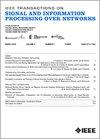存在异常值的图学习的惩罚似然方法
IF 3
3区 计算机科学
Q2 ENGINEERING, ELECTRICAL & ELECTRONIC
IEEE Transactions on Signal and Information Processing over Networks
Pub Date : 2025-02-10
DOI:10.1109/TSIPN.2025.3540701
引用次数: 0
摘要
图学习是图信号处理领域的一个重要问题。然而,实际应用中的可用数据经常受到异常值的污染,这使得传统方法的应用具有挑战性。在本文中,我们通过开发一种算法来解决这个问题,该算法可以有效地从被异常值损坏的节点信号中学习图拉普拉斯矩阵。具体来说,我们最大化了未损坏数据的惩罚对数似然,其中惩罚是通过错误发现率(FDR)原则选择的,涉及异常值的数量和位置,以及图拉普拉斯约束下数据的精度矩阵。为了说明对异常值的鲁棒性,我们将我们的方法与两种最先进的图学习方法进行比较,其中一种使用不同的性能指标考虑数据中的异常值,另一种不考虑。我们的研究结果表明,该方法可以有效地检测异常点的数量和位置,并在异常点存在的情况下准确地学习图。本文章由计算机程序翻译,如有差异,请以英文原文为准。
Penalized Likelihood Approach for Graph Learning in the Presence of Outliers
Graph learning is an important problem in the field of graph signal processing. However, the data available in real-world applications are often contaminated with outliers, which makes the application of traditional methods challenging. In this paper, we address this problem by developing an algorithm that effectively learns the graph Laplacian matrix from node signals corrupted by outliers. Specifically, we maximize the penalized log-likelihood of the uncorrupted data, where the penalty is chosen via the false discovery rate (FDR) principle, with respect to both the number of outliers and their locations, as well as the precision matrix of the data under the graph Laplacian constraints. To illustrate the robustness to outliers, we compare our method with two state-of-the-art graph learning methods, one that considers outliers in the data and one that does not, using different performance metrics. Our findings demonstrate that the proposed method efficiently detects the number and positions of outliers and accurately learns the graph in their presence.
求助全文
通过发布文献求助,成功后即可免费获取论文全文。
去求助
来源期刊

IEEE Transactions on Signal and Information Processing over Networks
Computer Science-Computer Networks and Communications
CiteScore
5.80
自引率
12.50%
发文量
56
期刊介绍:
The IEEE Transactions on Signal and Information Processing over Networks publishes high-quality papers that extend the classical notions of processing of signals defined over vector spaces (e.g. time and space) to processing of signals and information (data) defined over networks, potentially dynamically varying. In signal processing over networks, the topology of the network may define structural relationships in the data, or may constrain processing of the data. Topics include distributed algorithms for filtering, detection, estimation, adaptation and learning, model selection, data fusion, and diffusion or evolution of information over such networks, and applications of distributed signal processing.
 求助内容:
求助内容: 应助结果提醒方式:
应助结果提醒方式:


